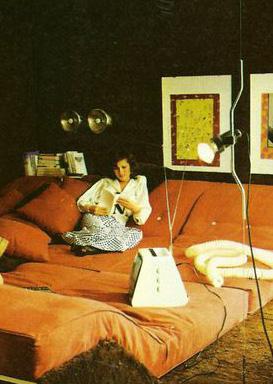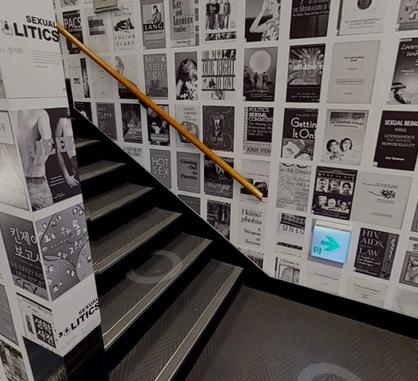
10 minute read
History of Cocooning
The History of Cocooning by Senna Wouters The History of
Cocooning
Advertisement
When I take you back to the good old days in the 70s, going partying all night long was one of the significant types of activities. But once mankind made its way into the early 80s, there was a shift in this specific human behavior. There were restaurants sitting with empty tables in the weekends and the dressing up and see your friends in bars around town was replaced by something way less active: Cable TV. This particular invention made its way into households and everyday life way faster than imagined and quickly became the superior activity above partying and going out. Why? Well, the Cable TV gave opportunities to almost every person in the household to place themselves in front of a tv screen and just stay there. For parents it showcased more and more movies and sports while for children it showcased their favorite to be cartoons. But the you-can-stay-home inventions didn’t end with the Cable TV. In 1983 the great invention of the (now unmissable) internet took place. People all of the sudden had the allowance to search, in the 80s, almost everything they wanted and needed. Before this invention mothers would go to their friendly neighbors to for example ask something about a recipe or fathers would connect in each other’s barns to discuss how to build this or that. This all was less common after the invention of then internet since people could search all of these on the computer. From easy and hard recipes, to do-it-yourself guidelines.
How Popcorn has predicted the future
Faith Popcorn also saw this major shift in social behavior. When you read the name Faith Popcorn, you may have heard about this person before. She is a successful futurist, author and CEO of her own marketing company called BrainReserve (that has a 95% accuracy track record for predicting cultural trends). After her studies at NYU she worked around eight years for an advertising company and later on started her own company in 1974. One of the major marketing advises she gave were to Coca-Cola that they should investigate and eventually go into bottled water and to Kodak to go into digital instead of print. But what is her connection with the behavior shift in the early 80s? Well, she was the person that gave it a name. She, even before the internet was invented and just Cable TV was around, already called it “cocooning”. This word became so well adapted into human lives that it even landed in the dictionary. Her prediction that came with naming this “trend” was that humans would want to protect ourselves from the crazy realities of the outside world. We would rather stay home, and watch videos than physically go and see a movie.
Differences within cocooning
According to Faith and her explained vision of cocooning in her 1990 book The Popcorn Report: The Future of Your Company, Your World, Your Life she gives us three different types of cocooning. First up there is the socialized cocoon that retreats to the privacy of its own home. Second in row is the armored cocoon, which establishes himself a barrier to protect itself from external threats. Lastly, we have the wandering cocoon. This type travels with a technological barrier which serves to insulate one from the environment.
What 4 decades of technology does
Between 1980, when the term was officially rolled into society, and anno 2020 there has been a various amount of changes and different views on what cocooning is. In 1980 the Cable TV and internet were the dominant factors that made us stay home more. 40 years later, a lot of new technologies and opportunities evolved to make staying at home easier than ever. First enormous factor; our smartphone. In this era of the technological integration into our daily lives, living without one is almost impossible. With just one device we can search the world wide web, stream videos and movies, read and write emails, do bank transfers and shop for an almost endless amount of product variation online. Speaking of this last benefit, shopping online has never been this easy. With just one click you can order your favorite sweater, and have it delivered within one business day, if not the same day. When we talk about ordering clothes online, this is just a very small percentage of all the variety that can get delivered to your door. If you have the Amazon app installed on your phone, just simply open it and search for anything you want, and you will find it. Delivered directly to your door.
Cocooning in a pandemic
When we place the term cocooning in the critical year of 2020, there are a lot of things to say about these two combined. As we all know, 2019 ended in not the greatest way we expected. With the outbreak of the COVID-19 virus in Wuhan, China, the World Health Organization officially called of an international emergency on January 30th, 2020. Just seven days after China put Wuhan, the epicenter of the outbreak, in lockdown and followed up by put out a nationwide one. Now, in the middle of spring season the world still is in full isolation. Asia and Europe have had a very strict and solid isolation of around two months, while the United States of America and parts of South America are starting to enter a nationwide isolation when the Middle East one is coming to its end. The word pandemic was for many people something they never wanted to hear in their lives, or hear again after the pandemics that’ve taken place in the past (for example; the 1918 and 2009 H1N1 pandemic and the 1968 H3N2 pandemic). The negative parts about this cocooning we have to endure now is that many people have lost their jobs or are currently unable to do their professions at home or without any social contact. Another negative part is that people cannot see their family, and most importantly their grandparent since they are the high-risk age group of not surviving the virus unfortunately. This is, alongside the whole cocooning opportunity, a very serious matter and we should not look at this happening with just the positive eye. This after all is a virus that created a worldwide pandemic that sadly takes and already has taken way too many lives that anybody would wish for. It is a very unfortunate and painful time for a lot of people who are not able to see their loved ones or people that lost a family member because of this COVID-19.
Born in a cocooning trend
Turning isolation into conversation
Now, what is the so important factor that cocooning brings beneficial to this quarantine-situations? Well, since nobody is allowed to leave their houses for invalid reasons, it is obligated to stay inside for as long as the virus keeps spreading around. And since cocooning is all about feeling comfortable in your own house and keep yourself busy while being inside, this trend has established enough to be well-adapted into the current situation that 2020 is going through. People are working from home, which gives people who are always at their office or on the road for work more home. People can finally refurbish that one spot in their house they say they would do for years now. From making banana bread every day to dying and bleaching our hair every other week. This quarantine has given us the possibility to do the stuff we postponed for so many years, which is one of the positive outcomes of this unforeseen happening. Another great positive element of this time and place we now need to live in, is turning isolation into conversation. With people not being able to see friends or family members, online conversations and videocalls are used more than ever. Organized yoga-classes through video calling services, having the usual Friday afternoon apéro with colleagues through FaceTime. When not focusing us on the technological part, cocooning still has evolved more and more over the decades that have passed since it first was determined. The curve of people wanting to stay home and just be by themselves has drastically increased. Beside all the in-home technologies and factors that the daily life us easily provide, people have found more and more comfort in being at their home. Millennials were born and raised in times where cocooning was established and had its uprising in daily lives. This was something they passed on to their Gen Z children who were born in the booming evolution of technology. From a very young age, children from this generation are exposed to factors such as smartphones, tablets, smart tv’s and so much more that provides them everything they need to stay in-home and entertain themselves daily with watching their favorite YouTuber or watch a children’s Netflix series (because Netflix has its own kids-section) or the newly enrolled streaming service of Disney+. The new generations are able to work more and more from home and also love to do that. From work they normally do at their work office and are progressively able to do it from home, to students that prefer doing essays and studying in their own room than doing it in school, on campus or in libraries.
Writer’s opinion
In general speaking of how people integrate the obligatory to stay inside I think it is safe to say that people have easily accommodated their normally very social and busy life to the less social contact standards now. People do see the extremely importance of saving other lives with staying inside and try to make the best out of it. It is only we as a population and as humans that we can restore the fun and easy life we once had before this pandemic. It is with sacrifice that mankind will become better than before. When it comes to my opinion about what has all been discussed in this article, I think that for Faith to determine this trend in the 80s was a very smart way of investigating something that has evolved so rapidly and big to this date and age we are now living in. It was already a little bit determined that with the introduction of Cable TV and the internet that lives at home would become easier, but nobody expected that the at-home services would boom to a level that it has become in 2020. If we could time travel to a time where Cable TV or internet did not exist nor did there was any insight on an eventually introduction of this and tell people that five or six decades later there would be this much variety to choose from of thing we could do just with one simple click on a mouse from the laptop on or lap in our couch, not many people would believe that this is what the future would bring. The unforeseen forced quarantine that 2020 brought along was a very good opportunity for people that did not exercise a lot of cocooning to take time to sit back and enjoy the littler things. Enjoy the sun shining, flowers blossoming and being able to look outside and see all the things nature and life bring to our lives for free. Even though the circumstances of this whole pandemic and too many people dying is the major displeasing feeling this way of living brings, it is a simple task and effort to achieve a greater cause when the world and lives restore to the way they a year ago were. My final words are that cocooning is trend that has become an almost daily happening for a huge percentage of the world’s population. People over the year became to more and more love being home, doing work from home and making sure their lives in home are stable just as the live they live outside their houses and are now able to combine those two to rule and succeed just from their own, cozy houses.












